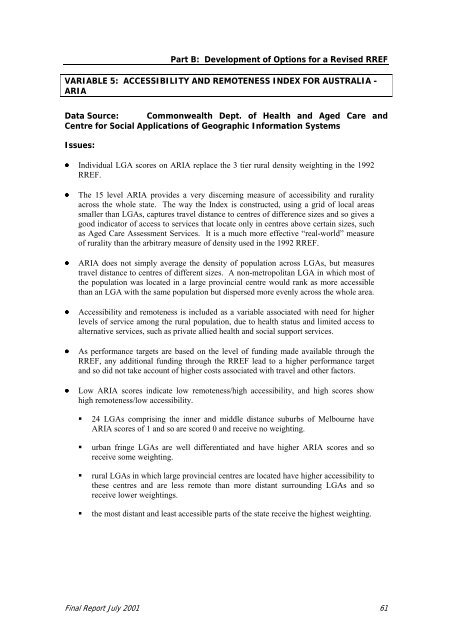Final Report on RREF 2001 - Department of Health
Final Report on RREF 2001 - Department of Health
Final Report on RREF 2001 - Department of Health
You also want an ePaper? Increase the reach of your titles
YUMPU automatically turns print PDFs into web optimized ePapers that Google loves.
Part B: Development <strong>of</strong> Opti<strong>on</strong>s for a Revised <strong>RREF</strong><br />
VARIABLE 5: ACCESSIBILITY AND REMOTENESS INDEX FOR AUSTRALIA -<br />
ARIA<br />
Data Source: Comm<strong>on</strong>wealth Dept. <strong>of</strong> <strong>Health</strong> and Aged Care and<br />
Centre for Social Applicati<strong>on</strong>s <strong>of</strong> Geographic Informati<strong>on</strong> Systems<br />
Issues:<br />
• Individual LGA scores <strong>on</strong> ARIA replace the 3 tier rural density weighting in the 1992<br />
<strong>RREF</strong>.<br />
• The 15 level ARIA provides a very discerning measure <strong>of</strong> accessibility and rurality<br />
across the whole state. The way the Index is c<strong>on</strong>structed, using a grid <strong>of</strong> local areas<br />
smaller than LGAs, captures travel distance to centres <strong>of</strong> difference sizes and so gives a<br />
good indicator <strong>of</strong> access to services that locate <strong>on</strong>ly in centres above certain sizes, such<br />
as Aged Care Assessment Services. It is a much more effective “real-world” measure<br />
<strong>of</strong> rurality than the arbitrary measure <strong>of</strong> density used in the 1992 <strong>RREF</strong>.<br />
• ARIA does not simply average the density <strong>of</strong> populati<strong>on</strong> across LGAs, but measures<br />
travel distance to centres <strong>of</strong> different sizes. A n<strong>on</strong>-metropolitan LGA in which most <strong>of</strong><br />
the populati<strong>on</strong> was located in a large provincial centre would rank as more accessible<br />
than an LGA with the same populati<strong>on</strong> but dispersed more evenly across the whole area.<br />
• Accessibility and remoteness is included as a variable associated with need for higher<br />
levels <strong>of</strong> service am<strong>on</strong>g the rural populati<strong>on</strong>, due to health status and limited access to<br />
alternative services, such as private allied health and social support services.<br />
• As performance targets are based <strong>on</strong> the level <strong>of</strong> funding made available through the<br />
<strong>RREF</strong>, any additi<strong>on</strong>al funding through the <strong>RREF</strong> lead to a higher performance target<br />
and so did not take account <strong>of</strong> higher costs associated with travel and other factors.<br />
• Low ARIA scores indicate low remoteness/high accessibility, and high scores show<br />
high remoteness/low accessibility.<br />
! 24 LGAs comprising the inner and middle distance suburbs <strong>of</strong> Melbourne have<br />
ARIA scores <strong>of</strong> 1 and so are scored 0 and receive no weighting.<br />
! urban fringe LGAs are well differentiated and have higher ARIA scores and so<br />
receive some weighting.<br />
! rural LGAs in which large provincial centres are located have higher accessibility to<br />
these centres and are less remote than more distant surrounding LGAs and so<br />
receive lower weightings.<br />
! the most distant and least accessible parts <strong>of</strong> the state receive the highest weighting.<br />
<str<strong>on</strong>g>Final</str<strong>on</strong>g> <str<strong>on</strong>g>Report</str<strong>on</strong>g> July <strong>2001</strong> 61
















